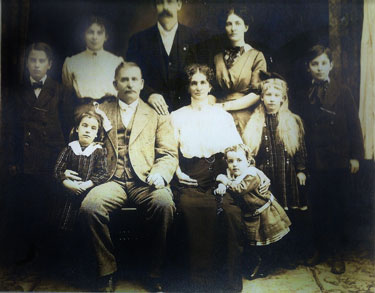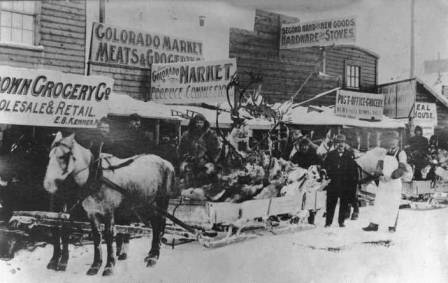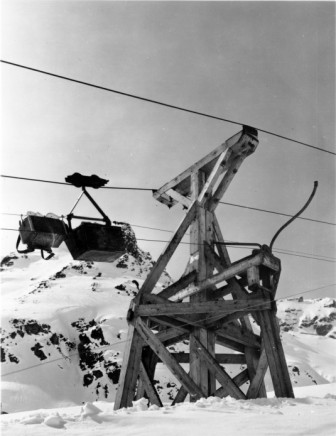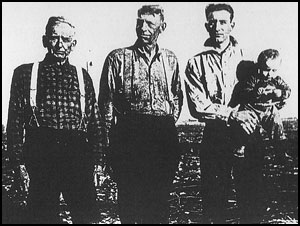Byron Sundlon Bartholf
(1850 - 1939)

Byron Bartholf and Family, circa 1909.
Front row from left: Mable Ruth Bartholf, Byron Bartholf,
Addie Bartholf, Magory Lola, Pearl Adean, and Chester Earl (Bartholf).
Back row from left: Ralph Sundlon Bartholf, Edith May,
John Tyler Bartholf, and Lola Leorna Smith.
John and Ralph are the sons of Byron and Addie Bartholf.
Photo: Courtesy of Lew Bartholf
The Bartholf family was in Knik by 1905, and was recording gold discoveries in the Willow Creek district as early as 1907 - the important Gold Bullion discovery made by Willliam Earl Bartholf. At least ten Bartholfs appear in early Cook Inlet history, and almost all had some connection with the Willow Creek mines. Byron Sundlon Bartholf was chosen for induction as the head of a family of dominant importance in the district; he fathered at least two of the more noted miners in the family, William Byron Bartholf and Charles Andrew Bartholf, and remained active in the district until very late in his life.
Byron Sundlon Bartholf was the fourth of eight surviving children, and was born to John D. and Sarah Jane Bartholf of Batavia, Genessee County, New York, on May 1, 1850. As reminded by historian Coleen Mielke, Byron was one day old at the 1850 Census. At least three of Byron's siblings came to Alaska: Frank G. born in 1846, Katherine (Kitty) born in 1851, and Eugene, born in 1859. By the 1870s, Byron's family was on the move westward. Sons William B., John T. and Charles A. were born in Colorado in the 1870s. A fourth son, Ralph S. was born to Byron and a second wife Amelia Amanda Smith in 1900 in the state of Washington.
Prior to Byron's move north, he prospected with four other partners, Enos and Monette Hotchkiss, James Sparling, and Ben Hall, in the Lake San Cristobal area, San Juan Mountain Range, Colorado. The group's 1874 discovery of the Golden Fleece Mine, destined to become one of the richest gold mines of the day, spurred the establishment and development of Lake City, Colorado. Each held a 1/5 interest in the claims, and when the claims were sold, Bartholf was paid $8,000 for his share, a goodly sum in those days. The Bartholf brothers' activities prior to their arrival in the Cook Inlet Region are sketchy, but Byron and his two younger brothers, Eugene and Frank, provided wild game meat for miners in Dawson, Yukon Territory, Canada, during 1900 and 1901.

Nine thousand pounds of moose and caribou killed by the Bartholf brothers being delivered in Dawson, Yukon Territory, Canada, February 10, 1900.
Photo from Alaska's Digital Archives.
The Bartholf family moved into the Willow Creek mining district of south-central Alaska in 1904 or 1905. District discoveries by the family include:
Gold Bullion (1907) - William E. and Byron Bartholf
Mabel (1911) - Charles A.(?) Bartholf
Gold Cord (1912) - Charles A. and Byron S.
Bartholf
Lucky Shot (1918) - Charles A. Bartholf
Discoveries made by the Bartholfs were followed up by development and operations. By 1909, the Bartholfs had built a two stamp mill on Craigie Creek to process Gold Bullion ore. The ore body lay far above the valley floor, and the ore was initially transported to the mill with pack horses. But operations of any efficiency required an enlarged mill fed by an aerial tramway. A tram 3,300 feet long was completed in 1910 to feed an enlarged mill. Later operations used relay trams to convey ore to a central main tramway. Eventually, a total of 6,300 feet of tram was installed. By 1913, thirty men were mining about 20 tons of high grade ore per day in an open season some four months long. By 1914, production totaled about 14,000 ounces, not bad for a seasonal operation with difficult logistics. A significant increase in production was realized when an infusion of capital was supplied by L. C. Thomson, who leased the property in 1916.

The Independence Mine ore tram as it appeared in 1937.
Photo from the Russ Dow Collection in the University of Alaska-Anchorage archives.
The Bartholfs also produced ore at Mabel and Gold Cord but their major property, Lucky Shot, proved to be the best in the district. It was also the scene of a family tragedy. The property was discovered in 1918, and was originally held by Charles Bartholf. By 1921, a substantial operation was underway managed by William B. Bartholf. On an August day, as William moved across the mill, his trousers were caught in machinery and a leg was almost torn off. His cousin Harvey Bartholf shut the plant down and mobilized the crew. The men raced for a waiting rail ambulance, but William died from shock before they reached the train.

John, Lola and Chester Bartholf, circa. 1919
Photo: Courtesy of Lew Bartholf
This may have been a critical happening to the Bartholfs. Their names, which had been the most important in the district, are heard with less frequency following the 1921 death of William Bartholf. Their name should survive in the district where they discovered most of the ore and began substantial mining operations. The Bartholf family was a tough and long lived bunch, and exceptionally good on the trail. W.E. Dunkle remembered that Byron, while in his 70s, was badly affected by palsy but could still knock over parky squirrels with a pistol at several tens of feet.

Four Generations of Bartholfs. From left, Byron Bartholf, son John Tyler,
grandson Chester and great grandson Duane.
Photo credit: Lew Bartholf
Byron S. Bartholf died at age 89 in Klamath Falls, Oregon. Brother Charles A. lived into his 70s, and Byron's youngest son Ralph S. died in California at age 91. Harvey Bartholf, who made a valiant effort to save William B. at the Lucky Shot, was the son of Byron's brother Frank and reportedly died at age 70.
By Charles C. Hawley, 2009
SOURCES
Note on Sources: The main published source used was William M. Stoll's "Hunting for Gold in the Talkeetna Mountains". A great debt is owed to Coleen Mielke from her long established project on the Herning diaries and for genealogical work on the Bartholf family. The note about pistol shooting ability of a 70-year old Byron Bartholf is from Reel 1, Tape 3 of the W.E. Dunkle tapes, which are in the possession of the Anchorage Museum.
Anchorage Times, on death of William B. Bartholf, August 22 (p. 5) and 25 (p.8), 1921
William M. Stoll, 1997, "Hunting for Gold in Alaska's Talkeetna Mountains, 1897-1951". Author, Ligonier Pennsylvania.
Charles Caldwell Hawley, 2003, "Wesley Earl Dunkle, Alaska's Flying Miner": Boulder, CO, University Press of Colorado, esp. Chapter7, Pardners Mines and the Lucky Shot
Website of Coleen Mielke "My Attempt to Untangle the Bartholf Family Tree, Willow Creek Mining District, Alaska"
